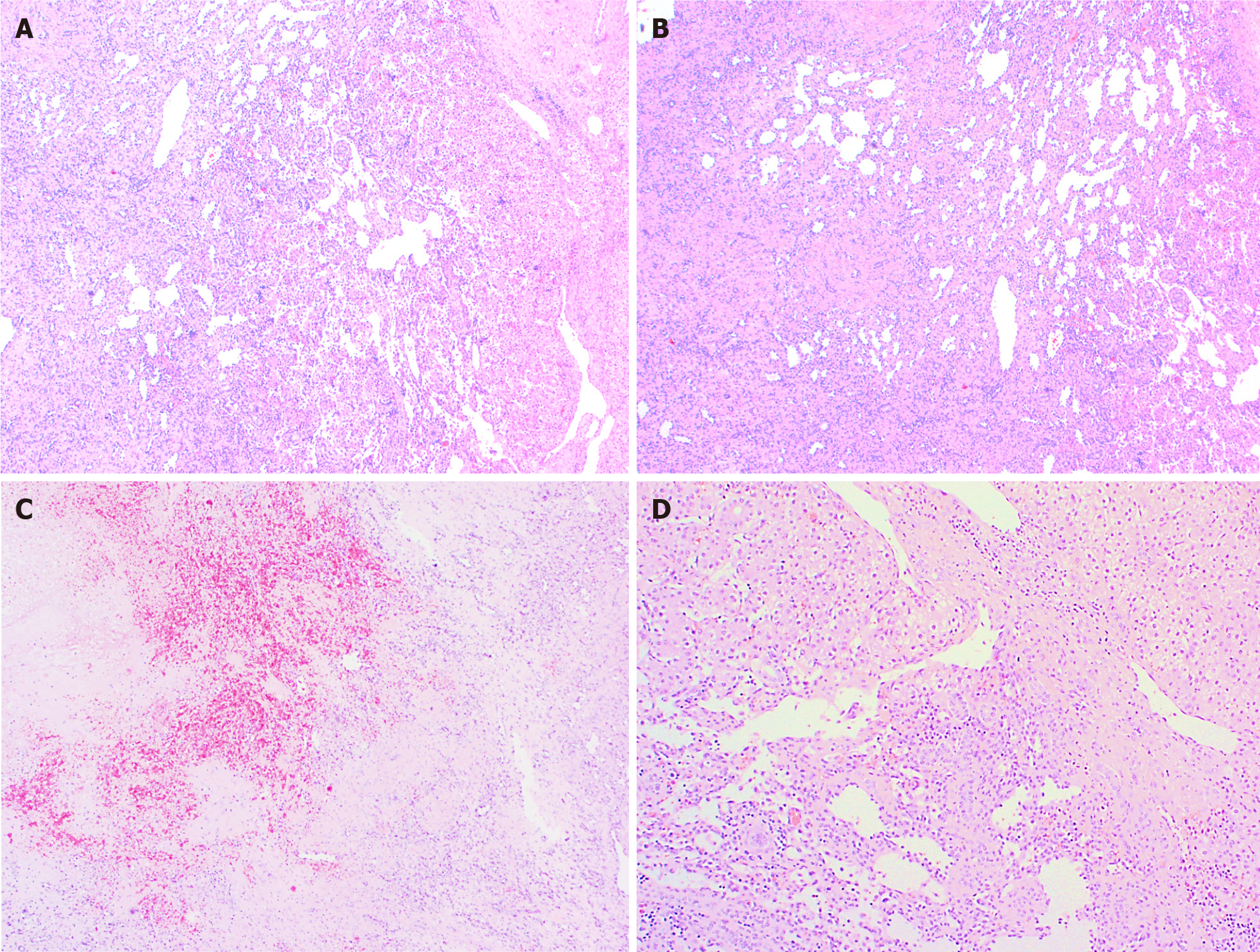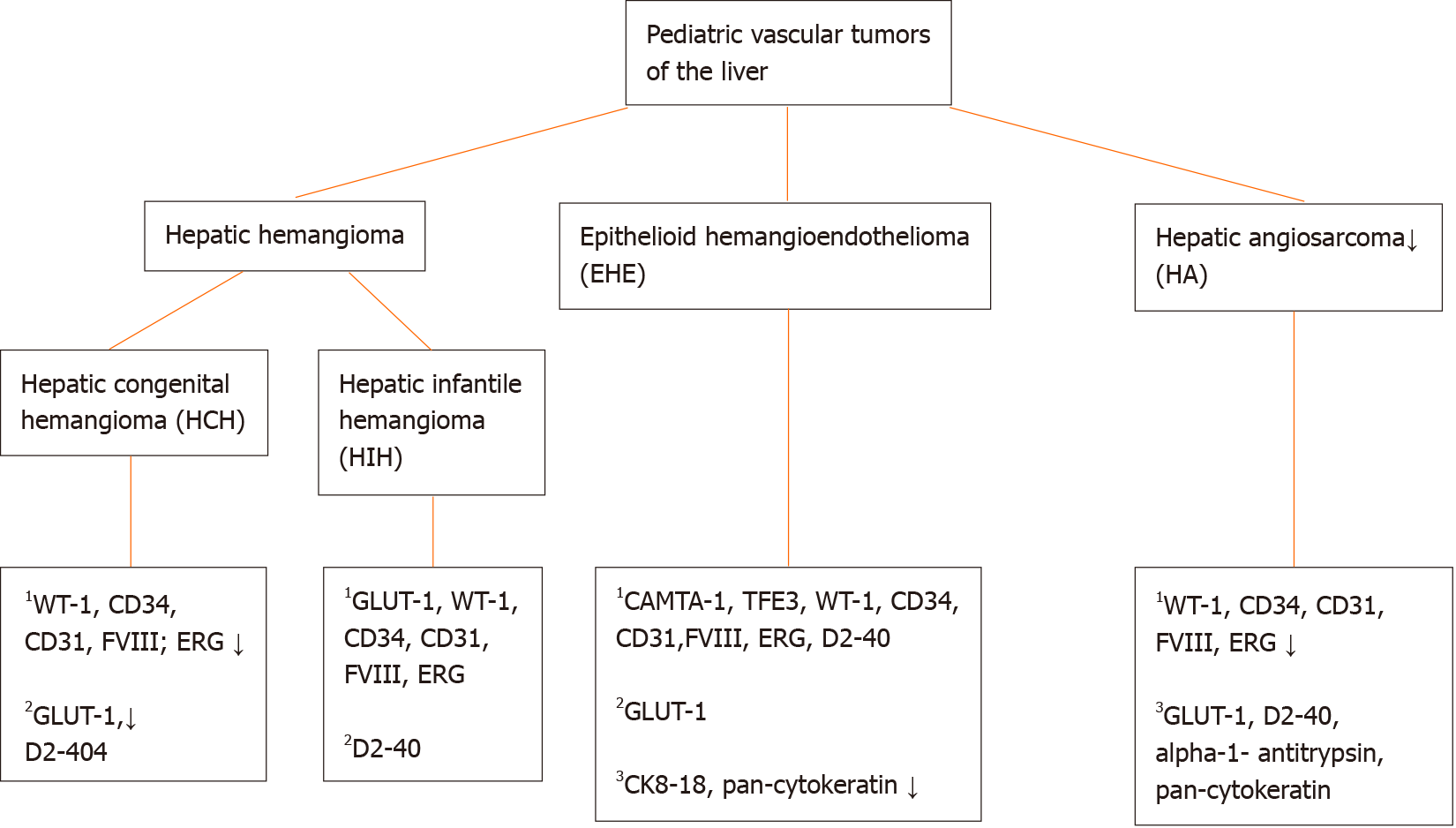Copyright
©The Author(s) 2021.
World J Hepatol. Oct 27, 2021; 13(10): 1316-1327
Published online Oct 27, 2021. doi: 10.4254/wjh.v13.i10.1316
Published online Oct 27, 2021. doi: 10.4254/wjh.v13.i10.1316
Figure 1
Histologic classification of hepatic hemangioendothelioma.
Figure 2 Hepatic congenital hemangioma.
A: A relatively well-demarcated vascular lesion; B: Lobules of variable sized, mostly small thin-walled vascular spaces and more abundant larger vessels at the periphery; C: Necrotic and hemorrhagic areas in the central part (area of involution); D: Entrapment of hepatocytes and bile ducts in interface areas.
Figure 3 Hepatic congenital hemangioma.
A: Erythroblast transformation-specific-related gene expression of endothelial cells; B: No GLUT1 expression of endothelial cells.
Figure 4 Hepatic infantile hemangioma.
A: A well-demarcated vascular lesion; B: Lobular, small-sized vascular spaces.
Figure 5 Hepatic infantile hemangioma.
A: Erythroblast transformation-specific-related gene expression of endothelial cells; B: Smooth muscle actin expression of the pericytic cells; C: GLUT1 expression of endothelial cells.
Figure 6 Hepatic epithelioid hemangioendothelioma.
A: Nests, cords, strands and single infiltrative epithelioid cells with intracytoplasmic vacuoles; B: Nests, cords, strands and single infiltrative epithelioid cells with intracytoplasmic vacuoles; C: Nuclear calmodulin-binding transcription activator1 (CAMTA1) expression; D: Nuclear CAMTA 1 expression.
Figure 7
Hepatic angiosarcoma, macroscopical features.
Figure 8 Hepatic angiosarcoma.
A: Unencapsulated vascular lesion; B: Infiltrative growth pattern; C: Anastomosing vascular spaces lined by endothelial cells with marked cytological atypia and multilayering. D: Anastomosing vascular spaces lined by endothelial cells with marked cytological atypia and multilayering.
Figure 9 Hepatic angiosarcoma.
A: CD31 expression of the endothelial cells; B: Erythroblast transformation-specific-related gene expression of the endothelial cells.
Figure 10 Overview pediatric vascular tumors of the liver and their immunohistochemistry.
1Positive immunohistochemical staining; 2Negative immunohistochemical staining; 3Occasionally positive immunohistochemical staining. WT-1: Wilms’ tumor 1; FVIII: factor VIII; ERG: Erythroblast transformation-specific-related gene; GLUT-1: glucose transporter-1; D2-40: podoplanin; CAMTA1: calmodulin-binding transcription activator1; TFE3: transcription factor E3; CK8-18: cytokeratin 8-18.
- Citation: Cordier F, Hoorens A, Van Dorpe J, Creytens D. Pediatric vascular tumors of the liver: Review from the pathologist’s point of view. World J Hepatol 2021; 13(10): 1316-1327
- URL: https://www.wjgnet.com/1948-5182/full/v13/i10/1316.htm
- DOI: https://dx.doi.org/10.4254/wjh.v13.i10.1316






















